Carole Terwilliger Meyers's Blog, page 27
April 7, 2017
Sights to See: Emperor Valley Zoo, Port of Spain, Trinidad
Emperor Valley Zoo Port of Spain. Daily 9:30am-6pm. TT30/US$5, under age 13 TT15. Named for the giant iridescent blue butterfly that once populated this valley, this small 7-acre zoo has been here since 1952 and is the largest in the Caribbean. It is currently being expanded and upgrading exhibits as it aims for accreditation. Assistant curator Richard Wallace says the aim is “to be a small San Diego Zoo.” It has an extensive collection of local animals (crab-eating raccoons, boa constrictors) and birds (the Trinidad motmot) plus flamingoes from the San Diego Zoo. Two large South American River Turtles are the oldest in Trinidad and have been here since the zoo opened. I saw two Trinidad white-fronted capuchin monkeys busy grooming each other, and two bright pink scarlet ibis perched way back in an enclosure. A circular path takes you past most exhibits. Two 3-year-old giraffes from Texas are the first in the Caribbean. A contest named them Melman (children’s choice, from “Madagascar” movie) and Mandela (adult’s choice, to honor Nelson, who had just died). The zoo has five white Bengal tigers, two of which were born at the zoo and are the first to be born in Trinidad and the Caribbean. If you visit, be sure to apply insect repellent. My souvenir was a bite, probably from a sand fly, and it left me with big red welts for several days--probably an allergic reaction. Note that the local natural treatment is to rub a lime on bites.
[image error] blue macaw at Emperor Valley Zoo in Trinidad
 flamingoes at Emperor Valley Zoo in Trinidad
flamingoes at Emperor Valley Zoo in Trinidad turtles at Emperor Valley Zoo in Trinidad
turtles at Emperor Valley Zoo in Trinidad Trinidad white-fronted capuchin monkeys at Emperor Valley Zoo in Trinidad
Trinidad white-fronted capuchin monkeys at Emperor Valley Zoo in Trinidad scarlet Ibis at Emperor Valley Zoo in Trinidad
scarlet Ibis at Emperor Valley Zoo in Trinidad
 giraffe at Emperor Valley Zoo in Trinidad
giraffe at Emperor Valley Zoo in Trinidad baboon at Emperor Valley Zoo in Trinidad
baboon at Emperor Valley Zoo in Trinidad playground at Emperor Valley Zoo in Trinidad
playground at Emperor Valley Zoo in TrinidadMore things to do in Trinidad.
More travel articles to inspire you and help you plan some spectacular getaways.
images ©2017 Carole Terwilliger Meyers
Published on April 07, 2017 10:17
Sights to See: Emperor Valley Zoo, Trinidad
Emperor Valley Zoo Daily 9:30am-6pm. TT30/US$5, under age 13 TT15. Named for the giant iridescent blue butterfly that once populated this valley, this small 7-acre zoo has been here since 1952 and is the largest in the Caribbean. It is currently being expanded and upgrading exhibits as it aims for accreditation. Assistant curator Richard Wallace says the aim is “to be a small San Diego Zoo.” It has an extensive collection of local animals (crab-eating raccoons, boa constrictors) and birds (the Trinidad motmot) plus flamingoes from the San Diego Zoo. Two large South American River Turtles are the oldest in Trinidad and have been here since the zoo opened. I saw two Trinidad white-fronted capuchin monkeys busy grooming each other, and two bright pink scarlet ibis perched way back in an enclosure. A circular path takes you past most exhibits. Two 3-year-old giraffes from Texas are the first in the Caribbean. A contest named them Melman (children’s choice, from “Madagascar” movie) and Mandela (adult’s choice, to honor Nelson, who had just died). The zoo has five white Bengal tigers, two of which were born at the zoo and are the first to be born in Trinidad and the Caribbean. If you visit, be sure to apply insect repellent. My souvenir was a bite, probably from a sand fly, and it left me with big red welts for several days--probably an allergic reaction. Note that the local natural treatment is to rub a lime on bites.
[image error] blue macaw at Emperor Valley Zoo in Trinidad
 flamingoes at Emperor Valley Zoo in Trinidad
flamingoes at Emperor Valley Zoo in Trinidad turtles at Emperor Valley Zoo in Trinidad
turtles at Emperor Valley Zoo in Trinidad Trinidad white-fronted capuchin monkeys at Emperor Valley Zoo in Trinidad
Trinidad white-fronted capuchin monkeys at Emperor Valley Zoo in Trinidad scarlet Ibis at Emperor Valley Zoo in Trinidad
scarlet Ibis at Emperor Valley Zoo in Trinidad
 giraffe at Emperor Valley Zoo in Trinidad
giraffe at Emperor Valley Zoo in Trinidad baboon at Emperor Valley Zoo in Trinidad
baboon at Emperor Valley Zoo in Trinidad playground at Emperor Valley Zoo in Trinidad
playground at Emperor Valley Zoo in TrinidadMore things to do in Trinidad.
More travel articles to inspire you and help you plan some spectacular getaways.
images ©2017 Carole Terwilliger Meyers
Published on April 07, 2017 10:17
April 5, 2017
Sights to See: The National Museum & Art Gallery of Trinidad & Tobago, Port of Spain, Trinidad
The National Museum & Art Gallery of Trinidad & Tobago 117 Frederick St., Port of Spain, (868) 623-5941. Tu-Sat 10am-6pm. Free. Though the exterior of its 1887 Dutch-gabled German-Renaissance-style building is modest, this museum holds interesting collections. The first floor features special exhibitions and natural history exhibits (you can see the magnificent blue Emperor butterfly here). Upstairs, the national art collection displays work by leading local artists, including paintings by Trinidad’s first major artist, Michel-Jean Cazabon (1813-88).
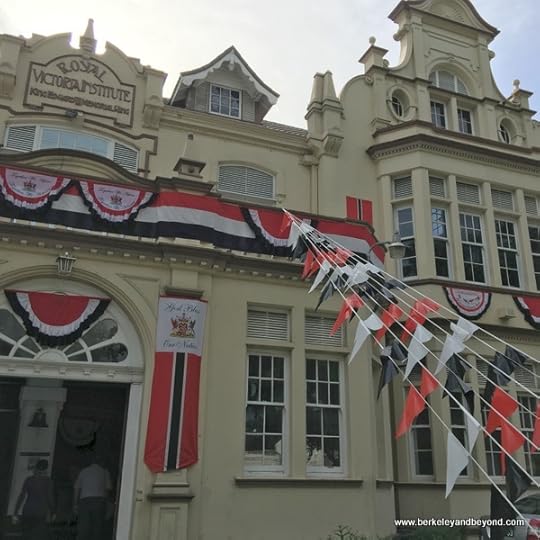 exterior of The National Museum & Art Gallery of Trinidad & Tobago in Port of Spain, Trinidad
exterior of The National Museum & Art Gallery of Trinidad & Tobago in Port of Spain, Trinidad special exhibit at The National Museum & Art Gallery of Trinidad & Tobago in Port of Spain, Trinidad
special exhibit at The National Museum & Art Gallery of Trinidad & Tobago in Port of Spain, Trinidad cocoa industry display at The National Museum & Art Gallery of Trinidad & Tobago in Port of Spain, Trinidad
cocoa industry display at The National Museum & Art Gallery of Trinidad & Tobago in Port of Spain, Trinidad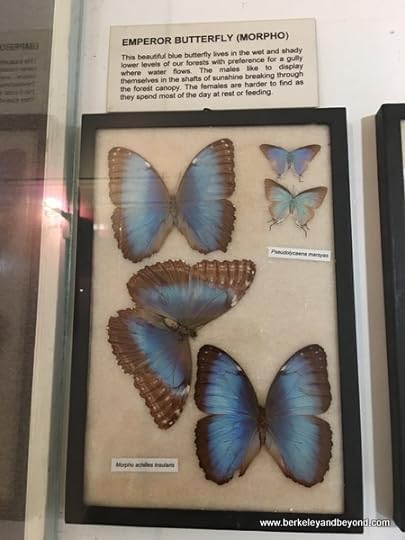 Emperor Butterfly display at The National Museum & Art Gallery of Trinidad & Tobago in Port of Spain, Trinidad
Emperor Butterfly display at The National Museum & Art Gallery of Trinidad & Tobago in Port of Spain, Trinidad art gallery at The National Museum & Art Gallery of Trinidad & Tobago in Port of Spain, Trinidad
art gallery at The National Museum & Art Gallery of Trinidad & Tobago in Port of Spain, Trinidad art gallery display at The National Museum & Art Gallery of Trinidad & Tobago in Port of Spain, Trinidad
art gallery display at The National Museum & Art Gallery of Trinidad & Tobago in Port of Spain, Trinidad art piece in gallery at The National Museum & Art Gallery of Trinidad & Tobago in Port of Spain, Trinidad
art piece in gallery at The National Museum & Art Gallery of Trinidad & Tobago in Port of Spain, TrinidadMore things to do in Trinidad.
More travel articles to inspire you and help you plan some spectacular getaways.
images ©2017 Carole Terwilliger Meyers
Published on April 05, 2017 13:33
Sights to See: The National Museum & Art Gallery of Trinidad & Tobago, Trinidad
The National Museum & Art Gallery of Trinidad & Tobago 117 Frederick St., (868) 623-5941. Tu-Sat 10am-6pm. Free. Though the exterior of its 1887 Dutch-gabled German-Renaissance-style building is modest, this museum holds interesting collections. The first floor features special exhibitions and natural history exhibits (you can see the magnificent blue Emperor butterfly here). Upstairs, the national art collection displays work by leading local artists, including paintings by Trinidad’s first major artist, Michel-Jean Cazabon (1813-88).
 exterior of The National Museum & Art Gallery of Trinidad & Tobago in Port of Spain, Trinidad
exterior of The National Museum & Art Gallery of Trinidad & Tobago in Port of Spain, Trinidad special exhibit at The National Museum & Art Gallery of Trinidad & Tobago in Port of Spain, Trinidad
special exhibit at The National Museum & Art Gallery of Trinidad & Tobago in Port of Spain, Trinidad cocoa industry display at The National Museum & Art Gallery of Trinidad & Tobago in Port of Spain, Trinidad
cocoa industry display at The National Museum & Art Gallery of Trinidad & Tobago in Port of Spain, Trinidad Emperor Butterfly display at The National Museum & Art Gallery of Trinidad & Tobago in Port of Spain, Trinidad
Emperor Butterfly display at The National Museum & Art Gallery of Trinidad & Tobago in Port of Spain, Trinidad art gallery at The National Museum & Art Gallery of Trinidad & Tobago in Port of Spain, Trinidad
art gallery at The National Museum & Art Gallery of Trinidad & Tobago in Port of Spain, Trinidad art gallery display at The National Museum & Art Gallery of Trinidad & Tobago in Port of Spain, Trinidad
art gallery display at The National Museum & Art Gallery of Trinidad & Tobago in Port of Spain, Trinidad art piece in gallery at The National Museum & Art Gallery of Trinidad & Tobago in Port of Spain, Trinidad
art piece in gallery at The National Museum & Art Gallery of Trinidad & Tobago in Port of Spain, TrinidadMore things to do in Trinidad.
More travel articles to inspire you and help you plan some spectacular getaways.
images ©2017 Carole Terwilliger Meyers
Published on April 05, 2017 13:33
March 31, 2017
Sights to See: steel pan yard, Port of Spain, Trinidad
The steel pan is the national instrument of Trinidad. First made from discarded oil drums when hand drums were banned under British rule, it is the only musical instrument invented in the 20th century.
Pans were originally informally pounded into a dish-like shape, tempered by fire, grooved, and tuned--until they were workable musical instruments. Now a standardized instrument, the tenor pan, or lead pan, carries the melody and can play 29 notes over 2.5 octaves in the higher register, while the newer G-Pan, originated at the University of the West Indies, can play 37 notes over 4 octaves. The pans need to be tuned every few months.
 pan musical instrument with standardized markings at Dan-Demonium pan yard in Trinidad
pan musical instrument with standardized markings at Dan-Demonium pan yard in Trinidadpan yards in Port of Spain Be sure to visit a pan yard for a performance that will knock your socks off. Look for posters around town advertising current performances.
 Invaders perform at pan yard in Trinidad
Invaders perform at pan yard in Trinidad●Dan-Demonium Pan player and song writer Kwesi Paul has been playing since he was 8 years old. Here you will see pans in various stages of formation.
 Kwesi Paul at Dan-Demonium pan yard in Trinidad
Kwesi Paul at Dan-Demonium pan yard in Trinidad●I saw the Invaders steel pan orchestra and the Les Coteaux Folk Performers calypso dancers perform at another pan yard.
 Darron Scotland of the Les Coteaux Folk Performers calypso dancers performs a delicate maneuver at a pan yard in Trinidad
Darron Scotland of the Les Coteaux Folk Performers calypso dancers performs a delicate maneuver at a pan yard in TrinidadJaffa restaurant is just across street. Named for the play in cricket that is a perfect delivery, this Mediterranean restaurant is situated at the home of cricket in Trinidad. A British high tea with scones and clotted cream is served on Wednesdays. Queens Park Oval, 94 Tragarete Rd., Level 2, (868) 622-6825.
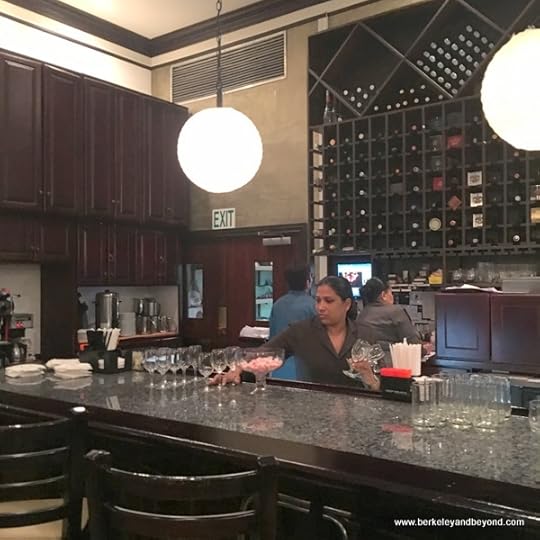 bar at Jaffa restaurant in Port of Spain, Trinidad
bar at Jaffa restaurant in Port of Spain, TrinidadMore things to do in Trinidad.
More travel articles to inspire you and help you plan some spectacular getaways.
images and videos ©2017 Carole Terwilliger Meyers
Published on March 31, 2017 13:12
Sights to See: steel pan yard, Trinidad
The steel pan is the national instrument of Trinidad. First made from discarded oil drums when hand drums were banned under British rule, it is the only musical instrument invented in the 20th century.
Pans were originally informally pounded into a dish-like shape, tempered by fire, grooved, and tuned--until they were workable musical instruments. Now a standardized instrument, the tenor pan, or lead pan, carries the melody and can play 29 notes over 2.5 octaves in the higher register, while the newer G-Pan, originated at the University of the West Indies, can play 37 notes over 4 octaves. The pans need to be tuned every few months.
 pan musical instrument with standardized markings at Dan-Demonium pan yard in Trinidad
pan musical instrument with standardized markings at Dan-Demonium pan yard in Trinidadpan yards in Port of Spain Be sure to visit a pan yard for a performance that will knock your socks off. Look for posters around town advertising current performances.
 Invaders perform at pan yard in Trinidad
Invaders perform at pan yard in Trinidad●Dan-Demonium Pan player and song writer Kwesi Paul has been playing since he was 8 years old. Here you will see pans in various stages of formation.
 Kwesi Paul at Dan-Demonium pan yard in Trinidad
Kwesi Paul at Dan-Demonium pan yard in Trinidad●I saw the Invaders steel pan orchestra and the Les Coteaux Folk Performers calypso dancers perform at another pan yard.
 Darron Scotland of the Les Coteaux Folk Performers calypso dancers performs a delicate maneuver at a pan yard in Trinidad
Darron Scotland of the Les Coteaux Folk Performers calypso dancers performs a delicate maneuver at a pan yard in TrinidadJaffa restaurant is just across street. Named for the play in cricket that is a perfect delivery, this Mediterranean restaurant is situated at the home of cricket in Trinidad. A British high tea with scones and clotted cream is served on Wednesdays. Queens Park Oval, 94 Tragarete Rd., Level 2, (868) 622-6825.
 bar at Jaffa restaurant in Port of Spain, Trinidad
bar at Jaffa restaurant in Port of Spain, TrinidadMore things to do in Trinidad.
More travel articles to inspire you and help you plan some spectacular getaways.
images ©2017 Carole Terwilliger Meyers
Published on March 31, 2017 13:12
March 28, 2017
Sights to See: Downtown Port of Spain, Trinidad
Originally a mangrove swamp, Port of Spain is now the second-largest in the Caribbean, after Kingston in Jamaica. Construction is going on everywhere, like in downtown San Francisco but on a smaller scale. Above-ground wire tangles are reminiscent of those in China and on my own residential street in California.
 tangle of wires in downtown Port of Spain, Trinidad
tangle of wires in downtown Port of Spain, TrinidadDowntown Shopping
●Frederick and Charlotte streets are the main shopping streets.
 corner shop in downtown Port of Spain, Trinidad
corner shop in downtown Port of Spain, Trinidad police car across street from Bang Bang shop in Port of Spain, Trinidad
police car across street from Bang Bang shop in Port of Spain, Trinidad● Excellent City Centre Considered the heart of downtown shopping, this popular shopping center has everything you might need under one roof--from designer clothing to electronics to jewelry--plus a bakery and food court. You’ll also find everything for the home, including appliances, toys, school supplies, children’s clothing, books, and souvenirs. You can even shop online.
(my articles: 3-24-17 my blog)
 Excellent City Centre mall in Port of Spain, Trinidad
Excellent City Centre mall in Port of Spain, Trinidad●KFC On Frederick St., across from Independence Square and a roundabout. This branch of finger-lickin’-good chicken made the Guinness World Records in 2000 for selling the most chicken in the world and also for making the most money world-wide. Trinidadians favor the spicy fried chicken.
 famous branch of KFC in Port of Spain, Trinidad
famous branch of KFC in Port of Spain, Trinidad● Holy Trinity Cathedral The oldest Anglican church in the Caribbean, this old building has a lovely mahogany ceiling.
 exterior of Holy Trinity Cathedral in Port of Spain, Trinidad
exterior of Holy Trinity Cathedral in Port of Spain, Trinidad interior of Holy Trinity Cathedral in Port of Spain, Trinidad
interior of Holy Trinity Cathedral in Port of Spain, TrinidadMore things to do in Trinidad.
More travel articles to inspire you and help you plan some spectacular getaways.
images ©2017 Carole Terwilliger Meyers
Published on March 28, 2017 13:17
March 24, 2017
Sights to See: Carnival, Trinidad
Carnival February 27 and 28 in 2017. Held in Port of Spain, on the Monday (party day) and Tuesday (activities are more structured; parade day) preceding Ash Wednesday. This massive event is the largest Carnival celebration in the Caribbean and the second largest in the world (Brazil is #1). Costumes are stunning, and many are elaborate and massive--large enough to fill a room. It is filled with music trucks, waving hands, and plenty of jumping. To attend, you should book one year in advance, and do consider booking a hotel or tour package.
Carnival participants have their favorite costume designer. Ronnie & Coro Mas Camp costumes (Warren/Ana sts, Woodbrook, 868-628-4521) is one of the best. The costume charge here is TT5,000+ (just under US$1,000) and includes everything--admission, food, drinks. Locals can no longer make everything in Trinidad. Feather items are still made here, but belts and many other items are now produced in China. “There are featherless birds and hairless horses in China because of carnival in Trinidad,” laughs Ronnie. Note that Carnival participants purchase new costumes every year!
 owner Ronnie of Ronnie & Coro Mas Camp costumes in Port of Spain, Trinidad
owner Ronnie of Ronnie & Coro Mas Camp costumes in Port of Spain, Trinidad worker at Ronnie of Ronnie & Coro Mas Camp costumes in Port of Spain, Trinidad
worker at Ronnie of Ronnie & Coro Mas Camp costumes in Port of Spain, Trinidad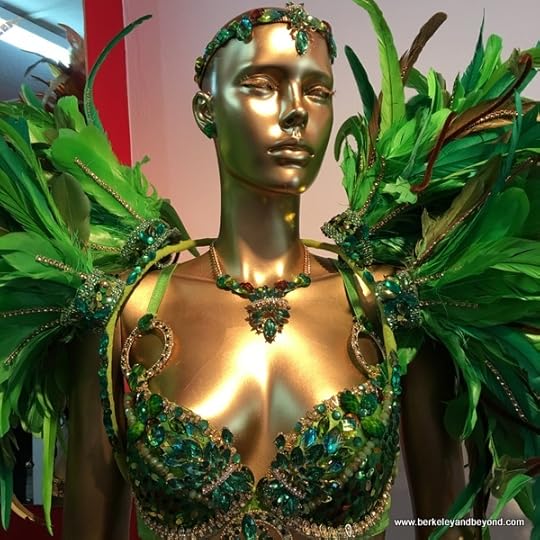 Carnival costume at Ronnie of Ronnie & Coro Mas Camp costumes in Port of Spain, Trinidad
Carnival costume at Ronnie of Ronnie & Coro Mas Camp costumes in Port of Spain, Trinidad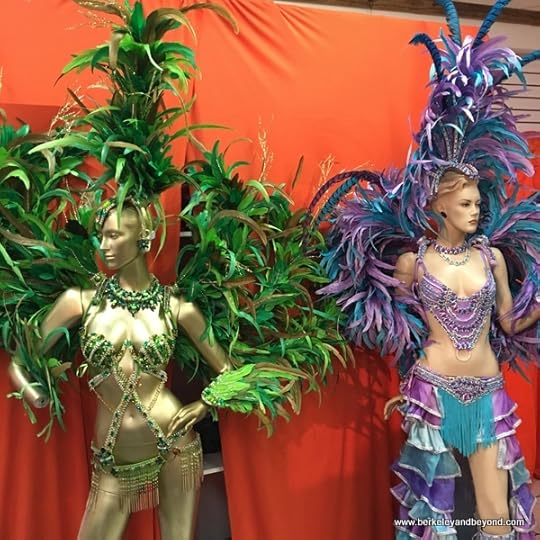 Carnival costumes at Ronnie of Ronnie & Coro Mas Camp costumes in Port of Spain, Trinidad
Carnival costumes at Ronnie of Ronnie & Coro Mas Camp costumes in Port of Spain, Trinidad travel writer Carole Terwilliger Meyers models feather costume at Ronnie of Ronnie & Coro Mas Camp costumes in Port of Spain, Trinidad
travel writer Carole Terwilliger Meyers models feather costume at Ronnie of Ronnie & Coro Mas Camp costumes in Port of Spain, Trinidad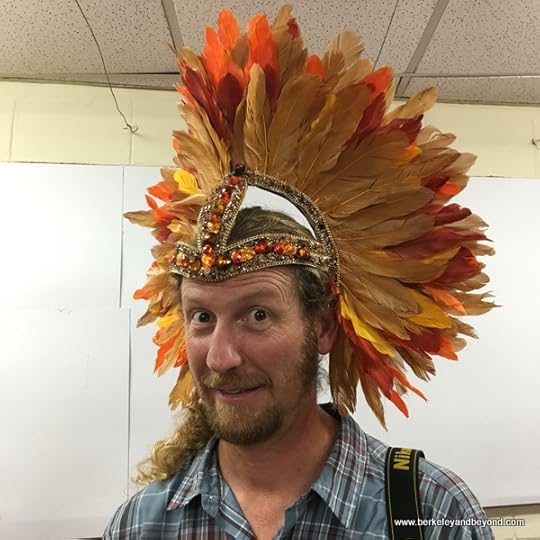 travel photographer Chad Case models feather headpiece at Ronnie of Ronnie & Coro Mas Camp costumes in Port of Spain, Trinidad
travel photographer Chad Case models feather headpiece at Ronnie of Ronnie & Coro Mas Camp costumes in Port of Spain, TrinidadMore things to do in Trinidad.
More things to do in Tobago.
More travel articles to inspire you and help you plan some spectacular getaways.
images ©2017 Carole Terwilliger Meyers; image of Carole Terwilliger Meyers c2017 Chad Case
Published on March 24, 2017 11:18
March 22, 2017
Sights to See: Trinidad & Tobago
An Overview:
TRINIDAD & TOBAGO
 Port of Spain cityscape in TrinidadLocated in the southeastern region of the Caribbean just 7 miles off the Venezuelan coast, Trinidad was in fact once part of South America until it broke off in an earthquake broke it off. They are the last island in the Caribbean chain.
Port of Spain cityscape in TrinidadLocated in the southeastern region of the Caribbean just 7 miles off the Venezuelan coast, Trinidad was in fact once part of South America until it broke off in an earthquake broke it off. They are the last island in the Caribbean chain. Britain gained control of the islands in 1797 and brought in thousands of African slaves to work on sugar, cotton, and indigo plantations. Today, descendants of those slaves make up most of Tobago's population. When Britain abolished slavery in 1830, landowners brought in indentured workers from India, China, and the Middle East. Their descendants give the islands a multi-ethnic appeal. According to a guide, “We are mixing it up,” and he said that Trinis celebrate their religions together and are inclusive rather than divisive.
Because the islands existed separately for centuries, they each have a distinct personality. Britain joined them together in the late 19th century, and the two islands gained independence in 1962 and became a republic in 1976.
The official language is English, and half of the annual visitors are from the U.S. People come here for the culture. Driving is on the left--except when it isn’t--so defensive driving is essential on both islands. “We drive like how we dance--dangerously,” an islander told me. There are no all-inclusive resorts.
TRINIDAD
Known as the “cultural capital of the Caribbean,” bustling Trinidad measures 65 miles long by 50 miles wide. It is the birthplace of the limbo, the calypso, and singer Harry Belafonte--as well as of the steel pan drum, the only acoustic instrument invented in the 20th century. It was ranked the happiest nation in the Caribbean by the United Nations’ World Happiness Report in 2013 and 2015. And though the island is lively and developed, the tourism infrastructure is not well-developed. You will find only one souvenir store downtown and no crafts market. U.S. service men stationed here during WW II--there were more than 200,000 of them--cut some of the roads that provide access to a mountain range and secluded beaches along the north coast.
TOBAGO
Tiny Tobago is only 30 miles long by10 miles wide and mostly undeveloped. Crown Point is the tourist hub, although Scarborough is the main town and where the cruise ships arrive. This lush island features hidden beaches, great diving, and quaint villages. It is home to the largest brain coral in the Western Hemisphere, and its Main Ridge Rainforest is the oldest protected reserve in the Western hemisphere.
FACES OF TRINIDAD AND TOBAGO
 Ricardo, a guide with Island Experiences in Trinidad
Ricardo, a guide with Island Experiences in Trinidad owners of Coloz restaurant in Port of Spain, Trinidad
owners of Coloz restaurant in Port of Spain, Trinidad server at HAKKA restaurant in Port of Spain, Trinidad
server at HAKKA restaurant in Port of Spain, Trinidad pan player and song writer Kwesi Paul at Dan-Demonium pan yard in Port of Spain, Trinidad
pan player and song writer Kwesi Paul at Dan-Demonium pan yard in Port of Spain, Trinidad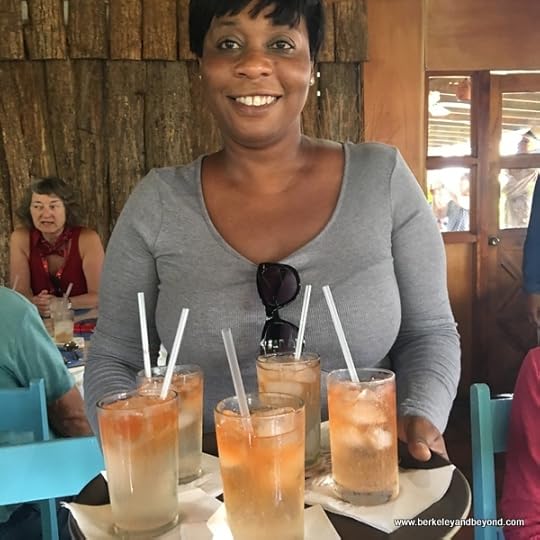 guide Monica helps serve drinks at Blue Crab Restaurant in Scarborough, Tobaygo
guide Monica helps serve drinks at Blue Crab Restaurant in Scarborough, TobaygoThings to do in Trinidad.
Things to do in Tobago.
More travel articles to inspire you and help you plan some spectacular getaways.
images ©2017 Carole Terwilliger Meyers
Published on March 22, 2017 15:48
March 9, 2017
Sights to See: San Diego de Alcala mission, San Diego, California
San Diego de Alcala mission 10818 San Diego Mission Rd., in Mission Valley, in San Diego. Founded by Father Junipero Serra in 1769 at a site near the mouth of the San Diego River, this was the first California mission. Also known as the San Diego Mission and the “Mother of the Missions,” it was relocated here--6 miles from its original site--in 1774 and has been rebuilt several times, making the current church the fifth on this site. It is now a peaceful island amid a busy shopping area. The mission church was named a minor basilica (a church of very important historical significance) by the Pope in 1976, and is one of only four of the California missions that are basilicas. Two striking features are its impressive bell tower featuring one original bell and the restored church featuring textured plastering typical of Indian craftsmanship. The well-maintained old gardens are also noteworthy. You can rent a taped tour, which kids 7 and older particularly enjoy. An annual Festival of the Bells that celebrates the mission’s founding takes place each July and includes a carnival and a blessing of both the bells and animals.
 front exterior of San Diego de Alcala mission in San Diego, California
front exterior of San Diego de Alcala mission in San Diego, California display of all the California missions in the museum at San Diego de Alcala mission in San Diego, California
display of all the California missions in the museum at San Diego de Alcala mission in San Diego, California bell tower at San Diego de Alcala mission in San Diego, California
bell tower at San Diego de Alcala mission in San Diego, California
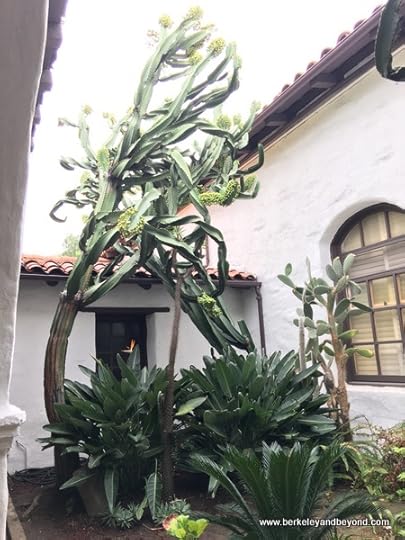 interior garden at San Diego de Alcala mission in San Diego, California Article about all 21 California missions.
interior garden at San Diego de Alcala mission in San Diego, California Article about all 21 California missions. More things to do in San Diego.
More information about San Diego.
Things to do in nearby La Jolla.
Travel articles to inspire and help you plan some spectacular local and foreign getaways. Travel articles to inspire and help you plan trips.
images ©2017 Carole Terwilliger Meyers
Published on March 09, 2017 11:30
Carole Terwilliger Meyers's Blog
- Carole Terwilliger Meyers's profile
- 1 follower
Carole Terwilliger Meyers isn't a Goodreads Author
(yet),
but they
do have a blog,
so here are some recent posts imported from
their feed.



